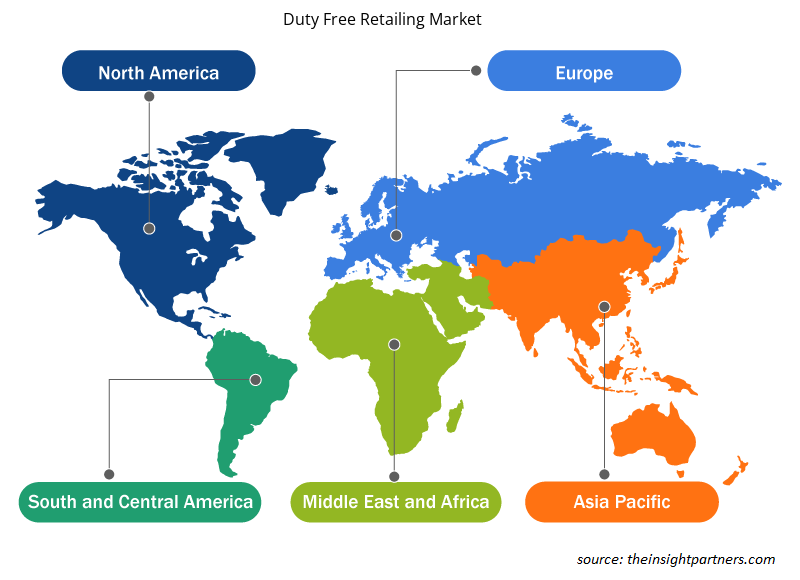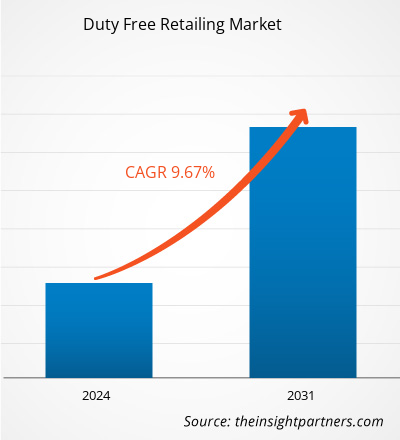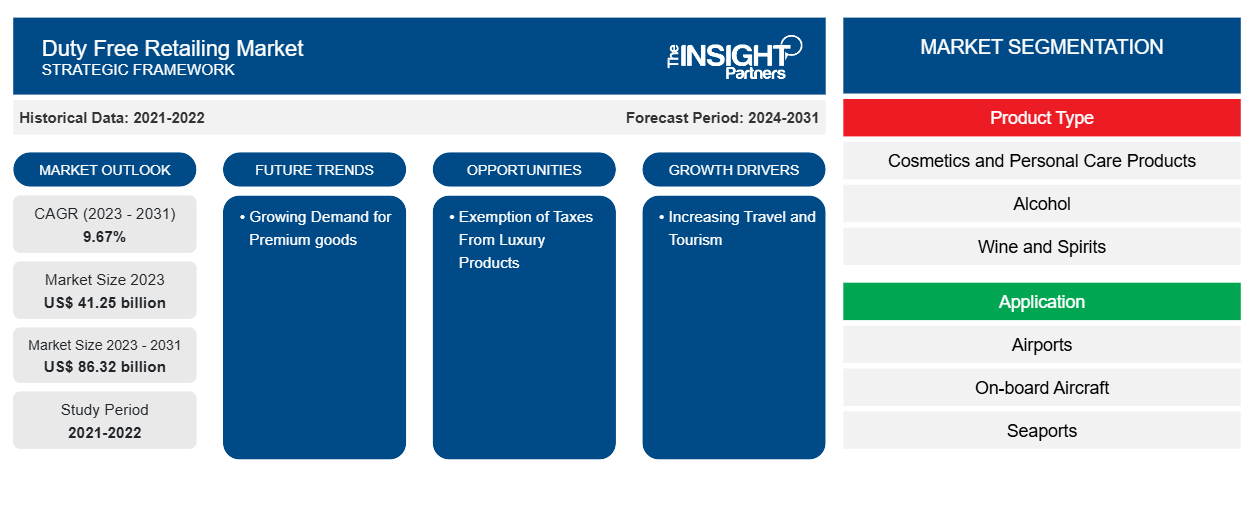Si prevede che la dimensione del mercato della vendita al dettaglio duty free raggiungerà gli 86,32 miliardi di dollari entro il 2031, rispetto ai 41,25 miliardi di dollari del 2023. Si prevede che il mercato della vendita al dettaglio duty free registrerà un CAGR del 9,67% nel 2023-2031. La crescente scomparsa dei prodotti di lusso e dello shopping one-stop.
Analisi del mercato della vendita al dettaglio duty-free
Crescenti investimenti e sviluppo del settore dei viaggi e del turismo, uniti all'integrazione di segmenti quali l'ospitalità e le infrastrutture, con il sostegno governativo per potenziare il settore dei viaggi e del turismo , con conseguente crescita del mercato della vendita al dettaglio duty-free.
Panoramica del mercato della vendita al dettaglio duty free
Il duty free retaining si riferisce ai punti vendita che contengono beni esentati dal pagamento di alcune tasse nazionali e locali; questa esenzione fiscale abbassa i prezzi rispetto ai normali negozi al dettaglio. I punti vendita duty-free offrono ai viaggiatori l'opportunità di risparmiare denaro su vari prodotti, come liquori, profumi, tabacco, cosmetici, elettronica e altro ancora. Il risparmio può essere significativo, in particolare per articoli di lusso costosi. Questi negozi duty-free sono strategicamente posizionati all'interno dei terminal degli aeroporti internazionali, rendendoli facilmente accessibili ai viaggiatori in partenza o in arrivo da altri paesi. Quindi, se i passeggeri hanno bisogno di acquistare articoli di cui potrebbero aver bisogno durante il loro viaggio o di acquistare souvenir e regali per amici e familiari, possono farlo facilmente in questi negozi duty-free.
Personalizza questo report in base alle tue esigenze
Riceverai la personalizzazione gratuita di qualsiasi report, comprese parti di questo report, o analisi a livello nazionale, pacchetto dati Excel, oltre a usufruire di grandi offerte e sconti per start-up e università
-
Scopri le principali tendenze di mercato in questo rapporto.Questo campione GRATUITO includerà analisi di dati che spaziano dalle tendenze di mercato alle stime e alle previsioni.
Driver e opportunità del mercato della vendita al dettaglio duty-free
Esenzione dalle tasse sui prodotti di lusso per favorire il mercato
Gli articoli duty free consentono ai consumatori di acquistare beni di lusso e di alta gamma a prezzi duty free. Con stili di vita frenetici, i consumatori preferiscono lo shopping one-stop e tale vendita al dettaglio duty free li aiuta a fare acquisti migliori e di lusso. Beni di lusso come profumi, orologi, sigari, alcolici di qualità, bigiotteria e altri sono gli articoli più attraenti nei negozi duty free a prezzi più bassi, il che attrae i consumatori. Inoltre, vari paesi stanno aprendo punti vendita al dettaglio di lusso duty free. Ad esempio, a novembre 2021, Louis Vuitton, un negozio di articoli di lusso duty free, ha aperto nell'hub dell'isola di lusso di Hainan. Pertanto, tale inclinazione verso i prodotti di lusso duty free guida la crescita del mercato della vendita al dettaglio duty free.
Aumento dei viaggi e del turismo
Secondo il primo World Tourism Barometer dell'anno dell'Organizzazione mondiale del commercio delle Nazioni Unite (UNWTO), il turismo internazionale ha chiuso il 2023 all'88%, con una stima di 1,3 miliardi di arrivi internazionali. L'ultimo World Tourism Barometer dell'UNWTO fornisce una panoramica completa delle prestazioni del settore nel 2023, tracciando la ripresa per regione globale, sottoregione e destinazione. Le entrate del turismo internazionale hanno raggiunto 1,4 trilioni di dollari nel 2023, secondo stime preliminari. Inoltre, si stima che il turismo cinese in uscita e in entrata accelererà nel 2024 grazie alla facilitazione dei visti e al miglioramento della capacità aerea. La Cina sta richiedendo l'esenzione dal visto per i cittadini di Francia, Italia, Germania, Paesi Bassi, Spagna e Malesia per un anno fino al 30 novembre 2024. Si prevede che l'Europa guiderà di nuovo i risultati nel 2024. A marzo, Romania e Bulgaria sono entrate a far parte dell'area Schengen di libera circolazione e Parigi ospiterà le Olimpiadi estive a luglio e agosto 2024. Tali favori all'aumento dei viaggi e del turismo aumenteranno i viaggi internazionali, il che creerà opportunità per la crescita del mercato della vendita al dettaglio duty free.
Analisi della segmentazione del rapporto di mercato del commercio al dettaglio duty-free
I segmenti chiave che hanno contribuito alla derivazione dell'analisi del mercato della vendita al dettaglio duty free sono il tipo di prodotto e l'applicazione.
- In base al tipo di prodotto, il mercato della vendita al dettaglio duty free è segmentato in cosmetici e prodotti per la cura della persona, alcolici, vino e liquori, tabacco e sigarette, moda, dolciumi e prodotti alimentari e altri.
- In base all'applicazione, il mercato della vendita al dettaglio duty free è segmentato in aeroporti, a bordo di aeromobili, porti marittimi e altri.
Analisi della quota di mercato del commercio al dettaglio duty free per area geografica
L'ambito geografico del rapporto sul mercato della vendita al dettaglio duty free è suddiviso principalmente in cinque regioni: Nord America, Asia Pacifico, Europa, Medio Oriente e Africa e Sud America/Sud e Centro America. La vendita al dettaglio duty free globale con l'aumento dei viaggi e del turismo e la crescita delle infrastrutture aeroportuali. Ad agosto 2023, Airports Council International (ACI) World prevede una crescita media annua del 5,8% nel traffico passeggeri tra il 2022 e il 2040. Entro il 2040, oltre 19 miliardi di passeggeri viaggeranno attraverso gli aeroporti mondiali ogni anno. A novembre 2023, Airport Council International ha riferito che la regione Asia-Pacifico ha un potenziale significativo per l'aviazione, poiché il 57% dei 300 aeroporti pianificati a livello globale stanno sorgendo in questa regione. Pertanto, tale crescita negli aeroporti e nel traffico passeggeri crea un'opportunità redditizia per la crescita del mercato della vendita al dettaglio duty free.
Approfondimenti regionali sul mercato della vendita al dettaglio duty-free
Le tendenze regionali e i fattori che influenzano il Duty Free Retailing Market durante il periodo di previsione sono stati ampiamente spiegati dagli analisti di Insight Partners. Questa sezione discute anche i segmenti e la geografia del Duty Free Retailing Market in Nord America, Europa, Asia Pacifico, Medio Oriente e Africa, e Sud e Centro America.

- Ottieni i dati specifici regionali per il mercato della vendita al dettaglio duty free
Ambito del rapporto sul mercato della vendita al dettaglio duty-free
| Attributo del report | Dettagli |
|---|---|
| Dimensioni del mercato nel 2023 | 41,25 miliardi di dollari USA |
| Dimensioni del mercato entro il 2031 | 86,32 miliardi di dollari USA |
| CAGR globale (2023-2031) | 9,67% |
| Dati storici | 2021-2022 |
| Periodo di previsione | 2024-2031 |
| Segmenti coperti |
Per tipo di prodotto
|
| Regioni e Paesi coperti |
America del Nord
|
| Leader di mercato e profili aziendali chiave |
|
Densità degli operatori del mercato del commercio al dettaglio duty-free: comprendere il suo impatto sulle dinamiche aziendali
Il mercato del Duty Free Retailing Market sta crescendo rapidamente, spinto dalla crescente domanda degli utenti finali dovuta a fattori quali l'evoluzione delle preferenze dei consumatori, i progressi tecnologici e una maggiore consapevolezza dei benefici del prodotto. Con l'aumento della domanda, le aziende stanno ampliando le loro offerte, innovando per soddisfare le esigenze dei consumatori e capitalizzando sulle tendenze emergenti, il che alimenta ulteriormente la crescita del mercato.
La densità degli operatori di mercato si riferisce alla distribuzione di aziende o società che operano in un particolare mercato o settore. Indica quanti concorrenti (operatori di mercato) sono presenti in un dato spazio di mercato in relazione alle sue dimensioni o al valore di mercato totale.
Le principali aziende che operano nel mercato della vendita al dettaglio duty free sono:
- Aer Rianta International (ARI)
- Società controllata da China Duty Free Group Co.,Ltd.
- Dubai Duty Free
- Duty Free America
- Il signor Heinemann
- Gruppo Internazionale King Power
Disclaimer : le aziende elencate sopra non sono classificate secondo un ordine particolare.

- Ottieni una panoramica dei principali attori del mercato del commercio al dettaglio duty free
Notizie e sviluppi recenti sul mercato del commercio al dettaglio duty-free
Il mercato della vendita al dettaglio duty free viene valutato raccogliendo dati qualitativi e quantitativi dopo la ricerca primaria e secondaria, che include importanti pubblicazioni aziendali, dati associativi e database. Di seguito è riportato un elenco degli sviluppi nel mercato:
- A marzo 2024, - Mumbai Travel Retail Private Limited (MTRPL) ha annunciato il suo rebranding in OSPREE. La nuova identità del marchio "Ospree" funge da strategia di MTRPL per integrare tutte le sue partecipazioni duty-free, tra cui Mumbai, Amritsar, Lucknow, Thiruvananthapuram, Jaipur, Ahmedabad e Mangalore,
(Fonte: Mumbai Travel Retail Private Limited, comunicato stampa, 2024)
- A gennaio 2024, Mumbai Duty Free ha annunciato un negozio Nappa Dori alle partenze dell'aeroporto internazionale Chhatrapati Shivaji Maharaj, segnando l'ingresso del marchio nel settore del travel retail. Nappa Dori, che si traduce in pelle e filo, è un marchio di origine indiana celebrato per i suoi articoli in pelle e accessori fatti a mano.
(Fonte: Mumbai Duty Free, Comunicato stampa, 2024)
Copertura e risultati del rapporto sul mercato della vendita al dettaglio duty-free
Il rapporto "Dimensioni e previsioni del mercato del commercio al dettaglio duty-free (2021-2031)" fornisce un'analisi dettagliata del mercato che copre le seguenti aree:
- Dimensioni e previsioni del mercato a livello globale, regionale e nazionale per tutti i segmenti di mercato chiave coperti dall'ambito
- Dinamiche di mercato come fattori trainanti, vincoli e opportunità chiave
- Principali tendenze future
- Analisi dettagliata delle cinque forze PEST/Porter e SWOT
- Analisi di mercato globale e regionale che copre le principali tendenze di mercato, i principali attori, le normative e gli sviluppi recenti del mercato
- Analisi del panorama industriale e della concorrenza che copre la concentrazione del mercato, l'analisi della mappa di calore, i principali attori e gli sviluppi recenti
- Profili aziendali dettagliati
- Analisi storica (2 anni), anno base, previsione (7 anni) con CAGR
- Analisi PEST e SWOT
- Valore/volume delle dimensioni del mercato - Globale, Regionale, Nazionale
- Industria e panorama competitivo
- Set di dati Excel
Report recenti
Testimonianze
Motivo dell'acquisto
- Processo decisionale informato
- Comprensione delle dinamiche di mercato
- Analisi competitiva
- Analisi dei clienti
- Previsioni di mercato
- Mitigazione del rischio
- Pianificazione strategica
- Giustificazione degli investimenti
- Identificazione dei mercati emergenti
- Miglioramento delle strategie di marketing
- Aumento dell'efficienza operativa
- Allineamento alle tendenze normative























 Ottieni un campione gratuito per - Mercato al dettaglio duty-free
Ottieni un campione gratuito per - Mercato al dettaglio duty-free